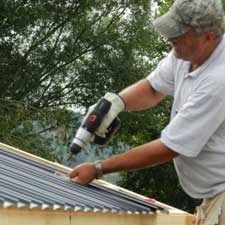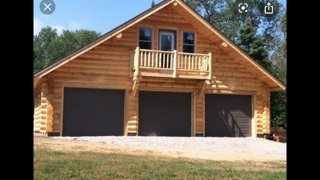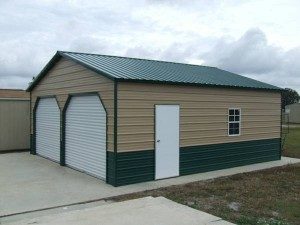To a property and casualty insurance company, the roof is the most important part of your pole building. Why? Because it’s the gateway to far greater damage claims once it’s breached.
“The roof is the first layer that wind, hail, wildfire and other hazards really begin to act on,” says Tim Reinhold, chief engineer at the Insurance Institute for Business and Home Safety, an independent, nonprofit research organization based in Tampa, Fla. “In more than 90 percent of hail or high-wind claims, there is a payout relative to the roof cover.”
With insurance, a lot rides on your roof.
Because insurers have a vested interest in your pole building roof, they price your property insurance accordingly, based on the soundness of its construction and what it will cost them to replace it. Note also premium incentives and disincentives for roof types vary widely by company and location.
Building near a wildfire zone? Example: Much of San Diego County, California. Any roofing other than a steel roof which won’t burn will either be prohibited by Code, or highly expensive to insure.
Check with your agent or broker before you build to see what impact the roofing type might have on your premium. Also keep a watchful eye, as insurance companies are moving more and more toward ‘actual cash value’ coverage for a roof and not paying the full replacement cost.
What’s the best pole building roof material choice for you?
 For most, through screwed steel roofing is going to be the material of choice. It is more cost effective (as a system) than even low grade “three-tab” shingles.
For most, through screwed steel roofing is going to be the material of choice. It is more cost effective (as a system) than even low grade “three-tab” shingles.
Steel is light weight – which is a plus over heavier roof options in high seismic areas, where roofing can be damaged by earthquake movement.
Unlike shingles, steel roofing is highly durable. Shingles fade, become brittle, attract mold and mildew, and may blow off in high winds. According to Reinhold, “Shingles age more than any other roof type”.
Steel roofing is also Class 4 rated against hail damage (read more at: https://www.hansenpolebuildings.com/blog/2011/09/steel-roofing/).
Manufacturer’s specifically name hail as an exclusion to their shingle product warrantee, as builders and roofing contractors. Newer roofs can actually be more susceptible to hail damage versus older roofs due to the time it takes a new roof to cure from exposure to the elements.
There are some added words of advice if you consider steel for your pole building roof. Metal reflects the sun’s rays, keeping attics cooler. Keep in mind, improperly installed (without insulation below) steel roofing can be noisy in severe rain or hail storms. Use good quality insulation, installed according to manufacturer’s directions, and your roof will be no noisier than other roofing types.
My wife and I have steel on all five of our buildings (WA & SD), and would never consider another choice. Several years ago when enough shingles blew off the roof of my wife’s former house (where her son now resides), causing leaks and dire need for replacement, we put steel right over the shingles. It looks great, keeps it cooler and we will most likely never have to do any sort of repair or maintenance to it with usual weather conditions.










Mike
My family property is in south east Virginia. Think hurricanes and ternimites. We have yellow pine and cypress board and batten structures approaching 100 years old with galvanized roofing that require almost no maintenance. They all have 12 to 18 inch over hang. Wood has not been painted in my 60 years. Roofs get painted about every 20 years. I put up a little stick built 12×12 shed over 30 years ago with T1-11 and 12 ” overhangs no paint, stain or sealer. It is still tight as a drum. Galvanized steel is the way to go. I’ll have to live another 60 years to comment on powder coat, which is by the way currently on the circa 1920 family home and 1950 garage.
Love your blog
Rob
Rob ~
Thank you for your kind words about the blog, it makes all of the effort totally worthwhile to know readers appreciate it!
P.S. I will be looking for your powder coating evaluation in 60 years.